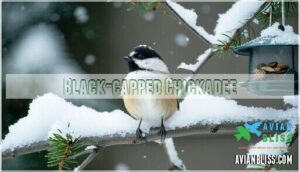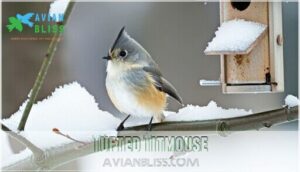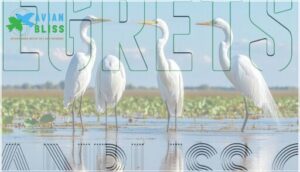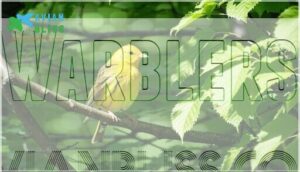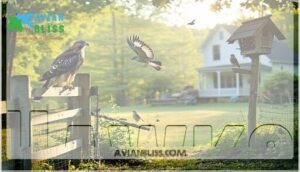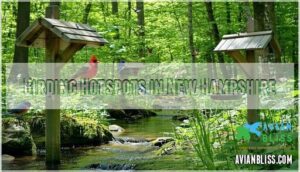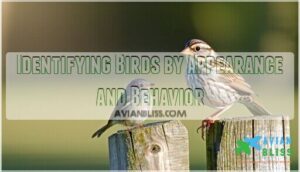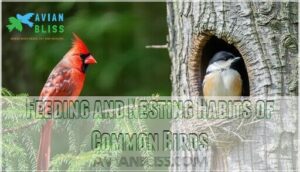This site is supported by our readers. We may earn a commission, at no cost to you, if you purchase through links.

Blue Jays, with their bold blue feathers and bossy attitudes, often steal the show. Keep an eye out for the sunny yellow American Goldfinch, especially in summer, and the clever American Crow, always up to something.
The Tufted Titmouse, with its perky crest, loves sunflower seeds. These backyard birds of New Hampshire bring color and song year-round.
Curious about rarer visitors or their quirky habits? Stick around—you’re in for a real treat! The variety of birds, including the American Goldfinch, ensures a fascinating experience.
Table Of Contents
- Key Takeaways
- Common Backyard Birds in New Hampshire
- Sought-after Bird Species in New Hampshire
- Birding Hotspots in New Hampshire
- Identifying Birds by Appearance and Behavior
- Feeding and Nesting Habits of Common Birds
- Frequently Asked Questions (FAQs)
- How do I identify a bird in my backyard?
- What are the ground dwelling birds in New Hampshire?
- When to put bird feeders out in NH?
- What is a small black bird with a white belly in NH?
- What is the most common bird in New Hampshire?
- What birds stay in NH for winter?
- How do I know what birds are in my area?
- How do seasonal changes impact bird migration patterns?
- What measures can help protect backyard birds?
- How can I attract rare birds to my feeder?
- Conclusion
Key Takeaways
- You’ll often spot common backyard birds like Black-capped Chickadees, Blue Jays, American Goldfinches, American Crows, and Tufted Titmice year-round in New Hampshire.
- Seasonal changes bring migratory birds like warblers, hawks, and loons, while hardy residents like chickadees and cardinals stick around during winter.
- Attract birds by offering sunflower seeds, nyjer, suet, and fresh water, and create a safe environment by avoiding pesticides and keeping cats indoors.
- Birding hotspots like Great Bay Wildlife Refuge, Hampton Beach State Park, and Odiorne Point State Park offer diverse habitats for observing both common and rare bird species.
Common Backyard Birds in New Hampshire
You’ll find five bird species dominating New Hampshire backyards year-round: the acrobatic Black-capped Chickadee with its distinctive black cap, the bold Blue Jay flashing brilliant blue feathers, the bright yellow American Goldfinch that turns olive in winter, the large all-black American Crow, and the crested Tufted Titmouse with its blue-gray plumage.
These common residents adapt well to suburban environments and readily visit backyard feeders, making them perfect starting points for beginning birdwatchers, especially with the bold Blue Jay and the American Goldfinch being frequent visitors.
Black-capped Chickadee
Spotting New Hampshire’s black-capped chickadee means witnessing nature’s ultimate survivor. These backyard birds charm with acrobatic feeder visits and distinctive "chick-a-dee-dee-dee" chickadee calls that vary by danger level.
The black-capped chickadee dazzles with fearless acrobatics and a call that shifts tones to signal danger.
You can find a chickadee bird feeder online.
- Chickadee habitat: Dense woodlands and suburban yards
- Winter survival: Cache thousands of seeds in bark crevices
- Chickadee diet: Insects, seeds, suet, and berries
- Chickadee predators: Hawks, cats, and larger birds
Blue Jay
Blue jays dominate New Hampshire backyards with their brilliant cobalt plumage and distinctive black necklace.
The bold Blue Jay dazzles with cobalt feathers and sharp calls, bringing vibrant energy to New Hampshire backyards year-round.
These intelligent birds exhibit complex Blue Jay behavior, from mimicking hawk calls to caching acorns.
Their Blue Jay diet includes nuts, seeds, and insects, while their harsh Blue Jay calls echo through deciduous forests.
Supplementing their diet with chewy Blue Jay food can provide essential nutrients.
You’ll find these striking NH birds year-round across their Blue Jay range.
American Goldfinch
American Goldfinch charms with its brilliant yellow summer plumage before shifting to olive-brown for winter.
These delightful NH birds prefer thistle seeds and demonstrate fascinating Goldfinch Migration patterns. Their bouncing flight and distinctive "potato-chip" calls make Goldfinch Behavior easy to recognize in backyard settings.
Nesting peaks in late summer, typically July and August.
Key Goldfinch Features:
- Goldfinch Diet consists primarily of nyjer and sunflower seeds
- Goldfinch Habitat includes weedy fields and suburban gardens
- Goldfinch Songs feature sweet, twittering melodies year-round
- Males display vibrant breeding colors from spring through summer
American Crow
Their unmistakable "caw caw" announces the American Crow’s arrival in your New Hampshire backyard.
These jet-black intelligence champions showcase remarkable crow behavior, from using tools to remembering human faces.
Their diverse crow diet includes everything from insects to garbage scraps.
Listen for varied crow calls beyond their signature caw—these common birds communicate through dozens of distinct vocalizations, making crow identification surprisingly complex.
Tufted Titmouse
Crested heads bobbing, tufted titmice bring year-round charm to New Hampshire backyards.
These gray acrobats with rusty flanks master upside-down feeding at your feeders.
Their clear "peter-peter-peter" whistle echoes through neighborhoods as they cache sunflower seeds for winter.
Watch them fearlessly approach – their bold behavior and cavity-nesting habits make backyard bird watching rewarding for New Hampshire birds enthusiasts.
Sought-after Bird Species in New Hampshire
You’ll discover that New Hampshire’s most coveted bird species, including Common Loons, Great Blue Herons, various scoter species, colorful warblers, and majestic hawks, require specific habitats and timing to observe successfully.
These sought-after birds often appear during migration periods or inhabit specialized environments like wetlands, coastal areas, and mature forests, making each sighting a rewarding experience for dedicated birders who enjoy observing majestic hawks.
Loons
New Hampshire’s roughly 300 loon pairs make these majestic birds a crown jewel for birdwatchers.
You’ll recognize their haunting loon calls echoing across pristine lakes, where loon conservation efforts have steadily boosted populations since 1975.
- Loon habitats: Large, clear lakes with abundant fish
- Loon diet: Primarily fish caught through expert diving
- Loon migration: Southward flights when lakes freeze over
Egrets
When spotting egrets in New Hampshire’s wetlands, you’ll encounter two distinct species with unique seasonal patterns.
These elegant waders captivate birders with their pristine white plumage and graceful fishing techniques.
| Species | Season | Habitat | Diet |
|---|---|---|---|
| Snowy Egret | Mid-May to July | Coastal marshes | Fish |
| Great Egret | Late summer | River valleys | Fish, frogs |
| Both species | Migration periods | Wetlands, estuaries | Aquatic prey |
| Conservation focus | Year-round | Protected habitats | Habitat preservation |
Scoters
Three scoter species grace New Hampshire’s winter coastline, making scoter identification an exciting challenge for backyard birds enthusiasts.
These sea ducks showcase distinctive black plumage with white markings, though females prove trickier to distinguish. Their scoter migration brings them from northern breeding grounds to our shores, where their scoter diet consists mainly of mollusks and crustaceans obtained through expert diving.
- Visit coastal areas during winter months for ideal bird watching
- Study male plumage patterns for easier common birds identification
- Monitor scoter habitats along rocky shorelines and jetties
- Support scoter conservation through responsible birding practices
Warblers
You’ll find warblers among New Hampshire’s most enchanting backyard birds during spring migration.
These colorful songsters, including the bright Yellow Warbler, fill woodlands with distinctive melodies.
Warbler identification becomes easier when you recognize their varied songs and vibrant plumage patterns.
Conservation efforts protect warbler habitats across the state, ensuring these remarkable bird species continue thriving in New Hampshire’s diverse ecosystems, with a focus on conservation efforts.
Hawks
Hawks soar majestically through New Hampshire’s skies, offering birdwatchers thrilling glimpses of nature’s apex predators.
These raptors showcase remarkable hunting prowess and migration patterns that’ll leave you mesmerized.
- Red-tailed Hawks: Circle overhead with distinctive rusty tail feathers
- Sharp-shinned Hawks: Dart through backyards pursuing songbirds
- Cooper’s Hawks: Demonstrate incredible agility around bird feeders
- Broad-winged Hawks: Form spectacular "kettles" during fall migration
Birding Hotspots in New Hampshire
You’ll find New Hampshire’s best birding spots offer diverse habitats that attract different species throughout the year, from coastal areas where you can spot waterfowl and shorebirds to inland refuges perfect for observing songbirds and raptors.
These locations provide excellent opportunities to see both common backyard species and harder-to-find birds, making them essential stops for anyone wanting to expand their bird identification skills, and observe a variety of species in their natural habitats, including raptors.
Great Bay Wildlife National Refuge
This birding sanctuary spans over 1,000 acres along Great Bay’s eastern shore in Newington.
Refuge Habitats include salt marshes, freshwater ponds, and woodlands supporting 230+ bird species.
Wildlife Surveys document Bird Migration patterns while Conservation Efforts protect nesting areas.
Visitor Activities feature hiking trails and birdwatching opportunities where you’ll spot backyard birds alongside rarer New Hampshire species in diverse bird habitats.
Hampton Beach State Park
Hampton Beach State Park transforms into a birder’s paradise during fall through spring when summer crowds disappear.
You’ll discover incredible shorebird sightings including all three scoter species, king eider, and black guillemot.
The park’s diverse park habitats attract loons, mergansers, and grebes during seasonal migration.
Perfect for bird photography and birdwatching enthusiasts seeking New Hampshire coastal bird species.
Odiorne Point State Park
Odiorne Point State Park serves as New Hampshire’s premier coastal birding destination, where diverse habitats support year-round species and seasonal migrations.
This conservation-focused location offers exceptional bird identification opportunities for backyard bird enthusiasts.
- Coastal Habitats: Rocky shores and salt marshes attract loons, egrets, and migrating warblers
- Seasonal Sightings: Spring and fall migrations bring rare species
- Park Birdwatching: Well-maintained trails provide ideal viewing angles
- Conservation Efforts: Protected ecosystems guarantee sustainable birdwatching trips
The park’s coastal location, like other mountain birding locations, supports diverse species.
Identifying Birds by Appearance and Behavior
You’ll find that successful bird identification combines careful observation of physical features like size, color patterns, and bill shape with behavioral clues such as feeding habits and flight patterns.
Learning to notice these combined characteristics helps you distinguish between similar species like the streaky Song Sparrow and the slate-gray Dark-eyed Junco, even when they’re moving quickly through your backyard.
Song Sparrow
You’ll recognize Song Sparrows by their streaked brown backs and distinctive dark central breast spot that looks like someone dotted them with ink.
These backyard birds prefer shrubby areas near water in New Hampshire.
Listen for their complex Song Sparrow Calls—melodic trills that sound like "sweet-sweet-sweet."
Their Habitat Preferences include gardens, wetlands, and brushy fields where they forage for seeds and insects.
Birders can improve their identification skills by analyzing sound characteristics.
Dark-eyed Junco
The Dark-eyed Junco is a backyard favorite in New Hampshire, especially during winter.
Its dark gray back, white belly, and flashing white tail feathers make it easy to spot.
These birds prefer coniferous forests but happily forage on the ground in leaf litter, often scratching like tiny chickens.
Listen for their soft trills—Junco vocalizations are subtle yet charming.
- Junco Habitat: Coniferous forests in breeding season, open areas in winter.
- Junco Diet: Seeds, insects, and berries.
- Junco Migration: Seasonal, moving southward for winter.
Hairy Woodpecker
The Hairy Woodpecker, a standout among New Hampshire’s backyard birds, sports bold black-and-white plumage and a long, chisel-like bill—perfect for insect hunting.
Its habitat preference leans toward mature forests, though it visits feeders too.
With a diet rich in insects, seeds, and fruit, this bird’s nesting behavior involves tree cavities.
Add it to your birdwatching list for a lively vocalization treat!
Red-winged Blackbird
The Red-winged Blackbird adds a splash of color to New Hampshire’s backyard birds.
Males flaunt bold red and yellow shoulder patches, singing proudly to claim territories.
They favor wetlands, nesting in cattails or shrubs near water.
Their diet is versatile, including insects, seeds, and grains.
- Blackbird Song: Males sing a distinct “conk-la-ree!”
- Habitat Preferences: Wetlands and marshy areas.
- Nesting Strategies: Build cup-shaped nests in vegetation.
Gray Catbird
The Gray Catbird, a favorite among backyard birds in New Hampshire, charms with its Catbird Song, mimicking a mewing cat.
Found in shrubs and thickets (prime Catbird Habitat), it snacks on insects and fruit (Catbird Diet).
This clever bird hides its twig-and-grass nests in dense vegetation. Spotting one adds excitement to any bird identification guide!
Feeding and Nesting Habits of Common Birds
You’ll notice that common backyard birds in New Hampshire have fascinating feeding preferences, from seeds and insects to berries and nectar.
Their nesting habits are just as unique, with some favoring tree cavities while others build intricate cup-shaped nests in shrubs or on ledges.
Eastern Phoebe
The Eastern Phoebe is a charming addition to your backyard birds in New Hampshire, known for its tail-wagging behavior, and this local bird thrives near water.
Its nesting and feeding habits include:
- Building mud-lined nests under bridges or eaves.
- Preferring insects like flies and beetles for its diet.
- Singing a raspy "fee-bee" tune.
- Adapting well to human-made structures.
They often require specific nesting materials for a successful nesting experience, which is a critical aspect of their breeding habits, and it’s also worth noting their ability to adapt to different environments. Keep an eye out!
House Finch
The House Finch is a cheerful addition to New Hampshire’s backyard birds.
Their feeding preferences include seeds and fruits, making bird feeders a magnet for them.
Males flaunt red plumage, while females sport streaked brown feathers.
You’ll often spot them in sheltered nesting spots, serenading with finch vocalizations.
- Seed-loving conical bills
- Bright red males
- Adaptable finch habitats
- Sociable finch behavior
Canada Goose
Unlike the House Finch, the Canada Goose is a heavyweight among backyard birds in New Hampshire.
Known for its iconic V-shaped Goose Migration, these local birds thrive near wetlands, ponds, and fields.
Their Goose Diet includes aquatic plants and grains.
Nesting on the ground, they fiercely guard their young, showcasing bold Goose Behavior that’s both protective and fascinating to observe.
They select nesting sites with safety and camouflage in mind.
Eastern Bluebird
Brighten your yard with Eastern Bluebirds, one of New Hampshire’s most charming backyard birds.
They thrive in Bluebird Habitats with open spaces and bird houses. Their Bluebird Diet includes insects and berries.
To support Bluebird Nesting, try these tips:
- Install nest boxes in sunny spots.
- Keep predators away with baffles.
- Plant native shrubs for food.
Chipping Sparrow
The Chipping Sparrow, a favorite among backyard birds, thrives in New Hampshire’s open forests and suburban yards.
Sporting a chestnut crown, it builds grass nests in shrubs from June to August. Its diet includes seeds and insects, often found near bird feeders.
Listen for its rapid, trilling song—a cheerful soundtrack for bird identification enthusiasts.
| Feature | Details | Fun Fact |
|---|---|---|
| Habitat | Shrubs, open areas | Adapts well to suburban settings |
| Diet | Seeds, insects | Attracted to backyard bird feeders |
| Nesting | Grass nests | Built low in shrubs |
| Song | Rapid trill | Sounds like a sewing machine! |
Frequently Asked Questions (FAQs)
How do I identify a bird in my backyard?
Look for size, colors, patterns, and behavior.
Does it have a crest, streaks, or unique markings?
Listen for calls or songs.
Grab binoculars, a field guide, and maybe a cup of patience!
What are the ground dwelling birds in New Hampshire?
Ever notice birds hopping along the ground instead of flying.
In New Hampshire, look for ground dwellers like the American Robin, Song Sparrow, and Dark-eyed Junco.
They forage for seeds, insects, and berries below.
When to put bird feeders out in NH?
Put bird feeders out in New Hampshire during late fall, around October, when natural food dwindles.
Winter feeding helps resident birds like chickadees and cardinals.
Keep feeders clean and stocked to attract feathered friends!
What is a small black bird with a white belly in NH?
You’re likely spotting a Black-capped Chickadee!
This tiny bird has a black cap, white cheeks, and a soft gray back.
They’re curious and love sunflower seeds, often flitting around feeders with cheerful energy.
What is the most common bird in New Hampshire?
Birdsong fills New Hampshire like nature’s symphony, and the Black-capped Chickadee takes center stage.
This small, gray bird with its black cap and cheerful “chick-a-dee-dee-dee” call is the state’s most common feathered friend, and its presence is a key part of the state’s natural beauty.
What birds stay in NH for winter?
In New Hampshire’s winter, you’ll spot hardy birds like Black-capped Chickadees, Blue Jays, Northern Cardinals, Tufted Titmice, and Downy Woodpeckers.
They brave the cold, often visiting feeders for sunflower seeds and suet.
How do I know what birds are in my area?
Check local birding guides, use apps like Merlin Bird ID, or observe feeders and habitats.
Pay attention to size, color, and calls.
Seasonal changes matter, so winter brings chickadees, nuthatches, and cardinals to watch.
How do seasonal changes impact bird migration patterns?
As seasons shift, birds sense changes in daylight and temperature, triggering migrations.
You’ll notice species like warblers heading south for warmth, while hardy residents like chickadees stick around, braving winter with clever foraging strategies.
What measures can help protect backyard birds?
Provide fresh water daily, plant native shrubs for shelter, and avoid pesticides to protect birds.
Add feeders with seeds like sunflower or nyjer.
Keep cats indoors—birds don’t appreciate surprise “hunters” in their habitat!
How can I attract rare birds to my feeder?
Transform your yard into a five-star buffet!
Offer specialized treats like suet for woodpeckers, fruit for waxwings, or safflower seeds for grosbeaks.
Add a birdbath, and you’ll host rare avian royalty in no time!
Conclusion
Like a painter’s palette, the backyard birds of New Hampshire bring vibrant colors and lively songs to your outdoor space.
From the cheerful Black-capped Chickadee to the bold Blue Jay, these feathered friends offer endless opportunities for observation and appreciation.
Keep your feeders stocked with sunflower seeds and your eyes peeled for rarer species like warblers or hawks.
Whether you’re a seasoned birder or just starting, there’s always something fascinating to discover in your backyard.

